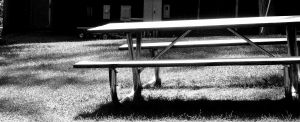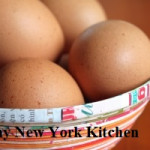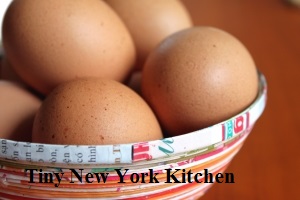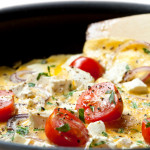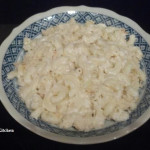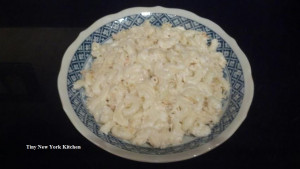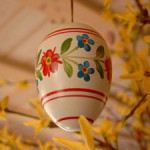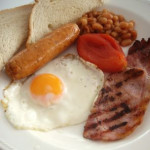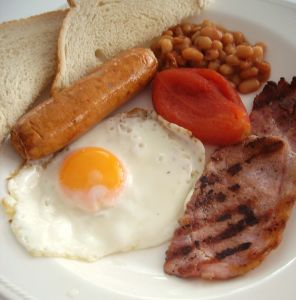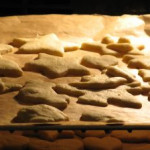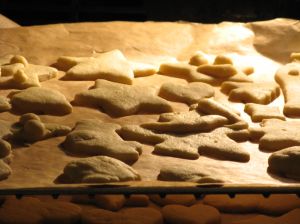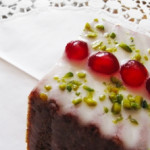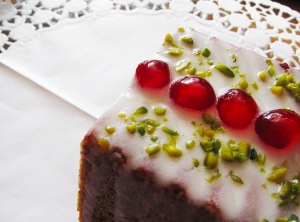Labor Day Weekend is the perfect weekend for a picnic. To celebrate the end of summer I’ve organized a feast of some of America’s favorites – from fried chicken to chocolate cake, cheeseburgers to homemade strawberry ice cream.
Parsley Potato Salad
Mushroom Artichoke Salad
Chile-Spiced Bean Salad
Crusty Parmesan Chicken Breasts
Deviled Eggs
Pickled Beets
Barbecued Cheeseburgers
Tomatoes
Radishes
Lettuce
Red Onions
Pickles
Olives
Chocolate Buttercream Cake
Strawberry Ice Cream
Strawberries
Beer
Lemonade
Coffee
Packing the picnic: The salads can be prepared a day in advance. It’s probably not necessary to double the recipes unless you have a large crowd to feed. Be sure to include a serving spoon for each salad. The Crusty Parmesan Chicken Breasts can be served either cold or warm. Either bake it a day ahead, refrigerate it, and carry it in a cooler; or pop it in the oven about an hour before you leave and transport it hot. The deviled eggs can be made from your favorite recipes or one from Tiny New York Kitchen. They will need several hours to chill and must be packed in a cooler, along with the assortment of vegetables (each in a plastic container). Take along a basket or platter for the chicken, a tray for the eggs, and serving forks.
All of the barbecue equipment can travel in a sturdy cardboard box, if there’s room, lay the buns and cheese on top so they don’t get squished. The hamburgers and condiments should be packed in a cooler.
You can bake the cake and prepare the frosting well in advance; both can be stored in the freezer. After thawing, the frosting should be beaten for a few minutes with an electric mixer. A round plastic serving plate with a high, tight-fitting cover is ideal for transporting the cake; remember to carry along a knife and a cake server.
In a cooler, pack the ice cream custard, berry mixture, and ice, each in its own container. Take a hammer and large, heavy dishtowel for crushing the ice cubes, and rock salt for the ice cream freezer (which would be a non-electric one). Pack the fragile ice cream cones and berries for garnish last.
Keep the beer in the cooler. For the lemonade and coffee, you will need a couple of thermoses. Preheat the one for the coffee; don’t forget to take cream (kept cold) and sugar. Pre-chill the other thermos and fill it with cold lemonade.
At the site: Assemble the ice cream freezer and begin hand-cranking, taking turns so that everyone can participate. If the ice cream is ready before it’s time for dessert, remove the dasher, cover the container, and let it stay in the freezer to ripen; don’t forget to dump out the salty water and pack the freezer with fresh ice.
Fire up the barbecue about 30 minutes before you want to begin cooking. Grill the cheeseburgers when the coals are gray. Arrange the chicken in a basket, set out the rest of the food, and dig in.
Do not transfer your eggs to the egg holder in the refrigerator door. This is actually the warmest place in the fridge and storing them there will hasten spoilage. Leave them in their carton and put them on a shelf.
There is no difference in flavor or nutritional value between white and brown eggs. Choosing one over the other is a matter of aesthetic preference. The breed of chicken determines the color of the eggshell.
To crack an egg with a clean break, rap it on a flat work surface. Eggs that are cracked on the edge of a bowl shatter more easily and you can end up with pieces of eggshell in the bowl.
Eggs are much easier to separate when they are cold. Most chefs learn to separate eggs by passing their contents back and for between halved shells, but this is not the greatest method as the sharp shells can cut into the yolk. It’s much better to use your hands. Working over a bowl, hold the egg in one hand and rap the egg on the work surface. Still using one hand crack the egg into your other cupped free hand. With practice you will soon be able to crack and open an egg with just one hand. Throw away the shell. Gently pass the egg back and forth to your cupped hands. Let the white slip through your fingers into the bowl while the yolk remains intact. Make sure to wash your hands well before starting this process and, of course, after you’ve separated the last egg.
Room temperature eggs will beat more easily because they will incorporate more air than cold eggs. To take the chill off of refrigerated eggs put the uncracked egg in a heatproof bowl and then add hot tap water to cover. Let stand for about 5 minutes.
To bring egg whites to room temperature, separate the cold eggs. Open them over a heatproof bowl so that the whites fall into it. Put the bowl in a larger bowl filled with hot tap water and let stand. Stir occasionally for about 3 minutes or just until the whites lose their chill.
Fat inhibits the aerations of egg whites. When you are beating egg whites make sure that there is not ANY fat that comes in contact with the whites. Bowls and beaters must be absolutely clean. Do not use a plastic or rubber bowl for beating egg whites because they seem to retain grease. To make sure that you have removed all grease from the bowls and beaters put the beaters in the bowl and add a generous splash of vinegar. Wipe out the bowl with paper towels and then wipe down the beaters with the vinegar soaked paper towels. Pour out any vinegar that may remain in the bowl, but do not rinse out the vinegar residue. Due to its acidity, vinegar will react with the egg whites and help them hold their shape when whipped.
For soft scrambled eggs, add a spoonful of heavy cream or milk when you beat the eggs. This should be about 1 tablespoon for every 2 eggs. Salt does toughen the eggs so don’t add the salt until after the eggs are cooked.
Poached eggs should have an attractive oval shape. First, use very fresh eggs, as their whites are firmer than older eggs. Regardless of age, it isn’t easy to get the whites to behave in simmering cooking water. Vinegar and salt will help set and control the spreading whites. Add 1 tablespoon of cider or distilled vinegar and 1/2 teaspoon of kosher salt to every quart of water. When the eggs are done, use a slotted spoon to transfer them to a bowl of hot tap water to rinse off the vinegar flavor and to hold the eggs for a few minutes before serving.
Hard-boiled eggs should be easy to cook. There are two common problems in cooking hard-boiled eggs. 1. Green-ringed yolks 2.Difficulty peeling. First, you should use eggs that have been stored for 7 to 10 days before cooking them. Older eggs are easier to peel. As the egg ages, carbon dioxide escapes through the shell, reducing the acidity of the white and acidity affects how the white clings to the shell. For peeling I find it easier to peel a hard-boiled eggs under running water.
Despite common belief, hard-boiled eggs should not be boiled for two reasons. First of all, the bubbling water can move the eggs so much that the shells crack. Second, it is easy to overcook eggs in boiling water. Overcooking will cause that horrible green ring that sometimes forms around the yolk. A better and easier way to cook the eggs is by putting them in a saucepan and cover with cold water. Bring to a simmer over a high heat. Take the pan off of the heat and cover with a lid. Let the egg stand in the water for 15 minutes. Pour off most of the water from the saucepan and then fill the pan with cold water. Let the eggs stand until they are completely cooled which should be for about 20 minutes. Crack and peel the eggs (under running water) immediately after cooling.
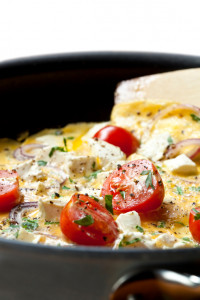 Pack Your Omelet Full Of Goodness
Pack Your Omelet Full Of Goodness
Omelets are one of those dishes that you can have for breakfast, lunch or dinner. The versatile omelet is low in calories too especially if you start with one egg and two egg whites (about 100 calories). Add the fillings of your choice and you have a protein packed meal that will satisfy your hunger.
Cheese Choices
Choose 1/4 cup of one of these cheese for your omelet.
Shredded Swiss
Shredded Cheddar
Crumbled Feta
Vegetables
Choose as many vegetables as you want because they are full of fiber and low in calories.
Chopped Broccoli
Sliced Mushrooms
Chopped Tomatoes
Proteins
Choose1/4 cup of these delicious proteins.
Smoked Salmon
Turkey Bacon
Ham
Optional
Choose one of these for a total treat.
Sautéed Potatoes
Avocado
Crème Fraiche
Forget that horrible box stuff and make your own delicious Mac & Cheese. Here is a different spin on the usual cheddar cheese macaroni & cheese dish. Using the brie, cream cheese and mascarpone makes it nice and creamy. I used macaroni pasta here, but you can use pasta shells or farfalle pasta.
INGREDNTS
2 Tablespoons Unsalted Butter
1/2 Teaspoon Kosher Salt
12 Ounces of Farfelle or Macaroni Pasta or Shells
7 Ounces Brie (Rind Removed) Cut Into Chunks
5 Ounces Cream Cheese Softened & Cubed
3 Large Eggs Lightly Beaten
1 Cup Mascarpone Cheese
1 Cup Grated Parmigiano Reggiano Cheese
3/4 Teaspoon Black Pepper
1/4 Teaspoon Finely Grated Nutmeg
Heat your oven to 375º F. Butter a 2 quart gratin dish. Bring a large pot of heavily salted water to a boil. Cook pasta to al dente and then drain well. DO NOT rinse the pasta. Transfer the hot pasta to a large bowl and toss immediately with Brie and cream cheese until melted and smooth. In a separate bowl, whisk together the eggs, mascarpone and Parmigiano. Stir the egg mixture into pasta. Season with the kosher salt, pepper and nutmeg. Place the pasta into the prepared baking dish. Bake for 30 minutes. Remove from the oven and serve immediately. Serves 6
Easter celebrates the resurrection of Jesus, but is also associated with popular symbols such as eggs, candy, bunnies and food. Here is a look at the origins of these beloved symbols.
The Easter Lily
The white blossoms of the lily symbolizes the purity of Jesus. The trumpet-shaped flower that blooms in the spring also symbolizes new life and the resurrection of Jesus Christ. People use the flower to celebrate and enjoy the very essence of the Easter season.
Hot Cross Buns
A favorite during spring and the Easter season. Hot cross buns are a sweet, yeast leavened, spiced roll made with currants or raisins. They have long been a symbol of Good Friday. Each bun has an icing cross on top to signify the crucifixion.
The Butterfly
The butterfly’s unique life cycle is meant to symbolize the life of Jesus Christ. The first stage, the caterpillar, stands for his life on Earth. The cocoon stage portrays the crucifixion and the burial of Jesus. The final stage, the colorful butterfly, represents Jesus rising from the dead and the resurrection.
Easter Baskets
In Germany, children made nests in which the “Osterhase” or Easter Bunny could lay his colored eggs. The nests were replaced with baskets once the tradition was brought to the United States and the Easter contents were expanded to include candy and other treats.
Easter Ham
In the United States ham has become a traditional Easter dish. In the early days, meat was slaughtered in the fall. There was no refrigeration so the fresh pork that wasn’t consumed during the winter was cured for spring. This made ham a natural choice for the celebratory Easter dinner.
Easter Egg Hunts & Rolls
The first official White House egg roll took place in 1878 under the presidency of Rutherford Hayes. Egg hunts and rolls have no religious connection, but some will point out that the roll is a symbolic act for the removal of the stone blocking Jesus’ tomb.
Easter Parade
The origin of Easter parades dates back to the mid-1800’s in New York City. The wealthy used Easter as an opportunity to show off their new spring wardrobe by walking up and down Fifth Avenue after church. Soon the less fortunate started showing up to watch the spectacle and a tradition was born.
Easter Candy
Second only to Halloween in candy sales, Easter is a holiday for children and adults with a serious sweet tooth. Chocolate eggs and candy shaped like bunnies or eggs are extremely popular. Also, jelly beans are often associated with the holiday due to their egg-like shape.
The Egg
Easter eggs are likely linked to pagan traditions, but eggs have long been used to celebrate spring and the idea of renewal. It’s not unusual that in almost all ancient cultures, eggs are held as a symbol of life. At the Passover Seder, a hardboiled egg dipped in salt water symbolizes both new life and the Passover sacrifice offered at the Temple of Jerusalem.
The Easter Bunny
The cute furry creature is certainly not mentioned in the Bible, but has nonetheless become the most well-known symbol for the spring holiday. The Easter Bunny’s origins are not entirely known, but some stories date his arrival in the United States back to the 1700’s when German immigrants brought their tradition of an egg laying hare called “Osterhase” to the country. Much like children leave cookies for Santa, boys and girls leave carrots out for the Easter Bunny in case he got tired from hopping around all night.
How lucky we are this year that Saint Patrick’s Day falls on the weekend so how about having a traditional full Irish breakfast.
Start with traditional bangers and then choose either Canadian bacon or double hickory smoked bacon. Add Eggs, grilled tomatoes, soda bread, baked beans and coffee or Irish breakfast tea. You can top your grilled tomatoes with grated cheese and herbs or have them just grilled. Your eggs can be fried, poached or scrambled.
Bangers are the cornerstone of the traditional full Irish breakfast. Irish loin bacon is very similar to Canadian bacon as both are cut from the pork loin and are fairly lean meats. They are cured and not smoked. Irish bacon also has a small bit of tail meat connected to the eye of the loin. Double hickory smoked bacon is very similar to American bacon or what is called streaky bacon in the British Isles. This type of bacon comes from the pork belly and is easily distinguished by the stripes of lean and fat that run through it. Double hickory smoked bacon is a fine substitute if you decide not to use Canadian bacon.
Irish breakfasts vary from cook to cook and region to region by incorporating local specialties. Some regional favorites include mashed potatoes that are fried with leftover vegetables, blood sausage or sautéed mushrooms.
Here Is An Interesting Way On How To Separate An Egg Yolk From The Egg White
http://bbs.wenxuecity.com/cooking/1160651.html
To enjoy cakes at their best, follow these tips:
*Allow cakes with butter type frosting to stand for about an hour before slicing.
This allows the frosting to set.
*For cakes that are filled or frosted with whipped cream make sure to assemble
Them no more than 2 hours before serving. This will prevent them from
Getting soggy.
*To cut your cakes use a thin bladed knife cut pieces. Run the knife under hot
Water and make sure to wipe the knife dry before cutting the first piece
And in between subsequent cuts.
*For storing cakes most cakes can be covered and stored at room temperature
For 2 to 3 days. It is good to have a cake cover, but if you don’t have
A cake cover then just invert a large bowl over your cake. If you directly
Cover the cake with plastic wrap then it will for sure make a mess of the
Frosting.
*For those cakes that have a filling or a frosting that contains eggs, whipped
Cream or cream cheese it is best to store your cake covered in the fridge.
*If you want to freeze your cake then you should put your cooled and unfrosted
Cake layers on a baking sheet. Freeze them until they are nice and firm.
After the layers are frozen then transfer them to large freezer bags or wrap
Them and seal them in freezer wrap. They will keep in the freezer for up to
4 months. Thaw them before frosting.
*If you are serving your cake directly from the pan then cover them and freeze
Them in the pan. Make sure to thaw them before frosting them.




